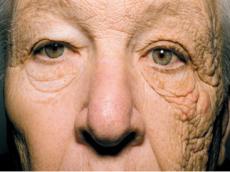|
|
TODAY.AZ / Weird / Interesting
Sun ages us?! - PHOTOS
02 June 2012 [11:10] - TODAY.AZ
 To most people it’s a curiosity, something to laugh about with the kids: you spend a few hours a day driving and by mid-summer, your left hand and arm are shades darker than the right.
To most people it’s a curiosity, something to laugh about with the kids: you spend a few hours a day driving and by mid-summer, your left hand and arm are shades darker than the right.But as a new case presented in the New England Journal of Medicine shows, left-sided sun damage is no laughing matter. Over the years, that lopsided suntan and a few extra freckles can mutate into deep creases, sagging skin and a general look that’s far older than your true age—and, too often, a high risk of skin cancer.
This man is a 69-year-old truck driver, making his living behind the wheel for the past 28 years. Half of his face looks normal for his age, but because he spent daytime hours with the sun to his left for nearly three decades, the left side of his face looks decades older.
The name for his condition is unilateral dermatoheliosis (one-sided photoaging). Driving with the sun beating down on his face and arm exposed the patient to damaging UVA rays for hours each day, just as if he had been lying on a beach with that skin exposed. Even with the window closed, UVA rays can penetrate window glass if not tinted enough to protect passengers inside the vehicle.
Sun worshippers pay a price for enjoying those drives in the sunshine, experts say. Researchers at the University of Washington studied cancer cases tracked by the U.S. government. Their findings, published in the American Academy of Dermatology, showed that when melanoma affected one side of a person’s body, it was on the left side—the driver’s side—52 percent of the time. Merkel cell cancers, another type of skin cancer, appeared on the left side in 53 percent of cases.
This isn’t the first evidence that motoring in the sun might be linked to skin cancer. A 2010 study of 1,047 skin cancer patients at the Saint Louis University School of Medicine, published in the same journal, came to the same conclusion: in both men and women, more skin cancers were found on the left side of the body than the right. And in Australia, where people drive on the right-hand side of the road, drivers’ right arms and right sides of their faces get the sun exposure. A 1986 study found that a majority of precancerous growths among Australian men occurred on their right sides.
Tinting window glass does afford some protection; compared to untinted glass, it admits 3.8 percent fewer UVA rays. The most protective color is gray, which admits only 0.9 percent of UVA light, compared to 62.8 percent of UVA light admitted through clear glass. (UVB rays don’t penetrate glass to a dangerous degree.)
But tinted glass can pose visibility issues. “People who are considering tinting their windows should take their car to a professional auto detailing shop, in order to ensure that the tinting meets the federally mandated 70 percent of minimum visible light transmittance through the windshield,” advises the American Academy of Dermatology. Auto glass tinting can be regulated by state law, and professional detailers will be aware of those guidelines.
/Yahoo/
URL: http://www.today.az/news/interesting/108131.html
 Print version
Print version
Views: 3253
Connect with us. Get latest news and updates.
See Also
- 19 February 2025 [22:20]
Visa and Mastercard can return to Russia, but with restrictions - 05 February 2025 [19:41]
Japan plans to negotiate with Trump to increase LNG imports from United States - 23 January 2025 [23:20]
Dubai once again named cleanest city in the world - 06 December 2024 [22:20]
Are scented candles harmful to health? - 23 November 2024 [14:11]
Magnitude 4.5 earthquake hits Azerbaijan's Lachin - 20 November 2024 [23:30]
Launch vehicle with prototype of Starship made its sixth test flight - 27 October 2024 [09:00]
Fuel prices expected to rise in Sweden - 24 October 2024 [19:14]
Turkiye strikes terror targets in Iraq and Syria - 23 October 2024 [23:46]
Kazakhstan supplied almost entire volume of oil planned for 2024 to Germany in 9 months - 23 October 2024 [22:17]
Taiwan reported passage of Chinese Navy aircraft carrier near island
Most Popular
 100 million is wasted: who pays for the fake history of the South Caucasus
100 million is wasted: who pays for the fake history of the South Caucasus
 New free trade accord reached between India and New Zealand
New free trade accord reached between India and New Zealand
 Opening of regional communications: equating to TRIPP
Opening of regional communications: equating to TRIPP
 "Garegin's days are numbered" is another reminder warning to the Armenian Catholicos
"Garegin's days are numbered" is another reminder warning to the Armenian Catholicos
 Azerbaijan’s FM honors Colombian Ambassador as he concludes mission
Azerbaijan’s FM honors Colombian Ambassador as he concludes mission
 Final statements delivered in trial of Armenian citizens at Baku Military Court
Final statements delivered in trial of Armenian citizens at Baku Military Court
 Shrines of Vardanyan family loot in Armenia devil in Baku
Shrines of Vardanyan family loot in Armenia devil in Baku


